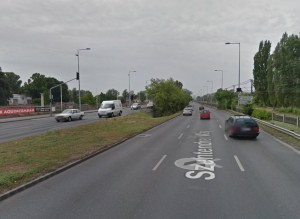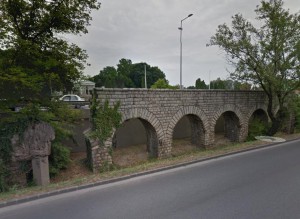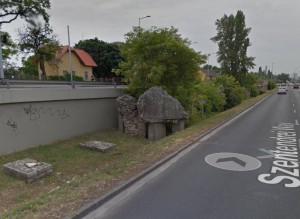The aqueduct and Roman limescale
First up on the blog is perhaps the most conspicuous Roman remains along Szentendrei Road. It’s also the easiest to view, given that the lights at the Szentendrei Road/Záhony Street intersection back up traffic all the way up to here in the morning, giving us the perfect opportunity to have a look.
So where are we now?
We’re heading south along Szentendrei Road. After passing the Aquincum HÉV stop and the Budapest-Esztergom railway bridge, in the road’s central reservation we see a rather strange structure.
But first the history!
As a matter of fact, the aqueduct begins not here, but at what’s now the Roman Lido (Római Strandfürdő). Mineral springs there – which are still flowing – supplied one of the greatest feats of engineering in Roman Budapest. The aqueduct brought running water not only to the Civil Town, but in certain time periods the legionary fortress and the Military Town as well. This means it supplied the baths we can now see in the Flórián Square underpass (Thermae Maiores) and, according to some, even the amphitheatre in Nagyszombat Street.
The water collected from the springs was pumped up into the aqueduct, which rested on pillars connected by arches. The slight gradient of the aqueduct ensured the continuous flow of water. The aqueduct crossed into the Civil Town by the northern gate and after a stretch of 450 metres crossed the southern wall and continued towards the Military Town.
The aqueduct was almost 5 km long and had a gradient of about 1 or 2 degrees. Water was probably drawn from various distribution and storage basins constructed along the aqueduct.
What can we see today?
About 70 metres after the small railway bridge, the first visible remains appear. Two sections (of 20 and 30 metres respectively) have been reconstructed, showing how the aqueduct would’ve looked like in its prime. Between them are the roughly waist-high pillar foundations, indicating the path of the watercourse. In many cases we can see what appear to be huge blocks of concrete. The aqueduct was made not from concrete but stone and mortar. The shapeless blocks were actually created by hard water. The water supply system continued to function long after the Romans had left, and the water flowing through cracks in the aqueduct began to form limescale blocks due to its high mineral content. The original pillars’ stumps are actually under these blocks, which we can see in several places.
The aqueduct, however, isn’t the only remains visible in the Szentendrei Road central reservation. But that’s the subject of the next blog post.
All in all, I encourage everyone to have a look at the ‘Roman limescale blocks’ on foot (for the best view), or from the warmth of your car on a cold morning – but only when the traffic isn’t moving!
Images from: Google Street View
Dániel Kővágó





